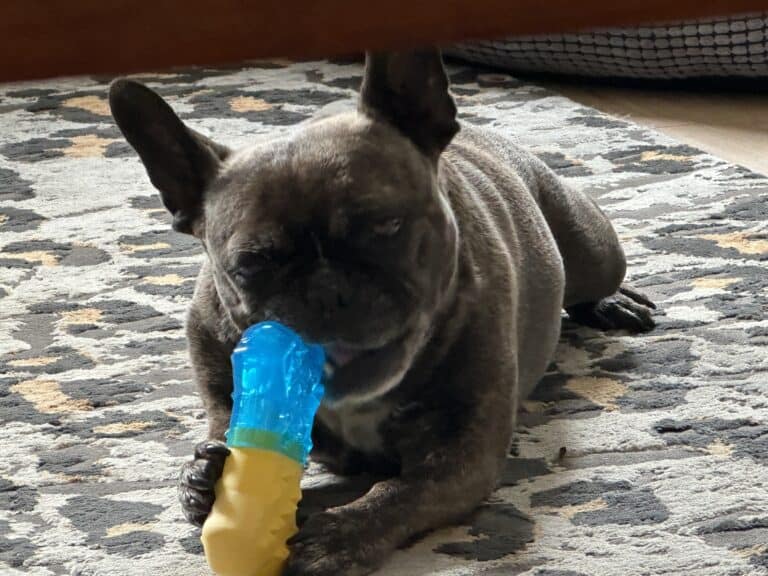Rescue Dog Separation Anxiety: Special Considerations and Gentle Approaches
The Pet Coach features affiliate links and participates in the Amazon Services LLC Associates Program. If you choose to make a purchase through one of these Amazon links, I may earn a small commission—at no additional cost to you. These affiliate earnings help support the website and allow me to continue providing free content for pet parents. For more details, please see my disclosure policy.
When you welcome a rescue dog into your home, you’re not just adopting a pet—you’re inheriting their emotional history. These resilient animals often carry invisible wounds from abandonment, neglect, or multiple rehoming experiences that can manifest as intense separation anxiety. Unlike puppies raised in stable environments, rescue dogs may panic when left alone, viewing your departure as confirmation of their deepest fears. Understanding their unique psychological landscape becomes essential for helping them heal and find peace in solitude.
Understanding the Unique Challenges Rescue Dogs Face
When you welcome a rescue dog into your home, you’re often caring for an animal who’s experienced profound loss and uncertainty. Their past abandonment, neglect, or harsh living conditions create a foundation where rescue dog separation anxiety can easily develop.
These dogs haven’t learned that temporary departures don’t mean permanent abandonment. You’ll notice they form intense attachments quickly, viewing you as their lifeline after experiencing betrayal or loss. This creates a cycle where they struggle with independence, constantly seeking reassurance of your presence.
Their hypervigilance stems from survival instincts developed during uncertain times. Unlike dogs raised in stable environments, rescue dogs interpret separation as potential danger. Understanding the importance of separation anxiety in these cases helps you approach their anxiety with patience rather than frustration, recognising their behaviour as adaptive responses to trauma.
Recognising Signs of Separation Anxiety in Rescue Dogs
You’ll need to watch for specific behavioural patterns that signal your rescue dog’s anxiety before it escalates into destructive episodes.
These signs often appear in predictable sequences, starting with subtle changes in your dog’s demeanour when you prepare to leave and progressing to more obvious physical manifestations of stress.
Distinguishing between genuine separation anxiety and underlying medical conditions requires careful observation of when, where, and how these behaviours occur. Effective management techniques can also help alleviate your dog’s anxiety during these times.
Early Warning Behavioural Signs
The behavioural signs of separation anxiety in rescue dogs often emerge subtly before escalating into more severe symptoms.
You’ll notice excessive barking or howling when you first leave your newly adopted dog alone. Watch for pacing or restlessness as your dog senses you’re preparing to leave—this indicates mounting anxiety about impending separation.
Destructive behaviours like chewing furniture or personal items signal distress and emotional dysregulation. Even house-trained dogs may experience incontinence due to heightened stress levels when left alone. These accidents aren’t defiance but rather involuntary responses to overwhelming anxiety.
Consider monitoring your dog’s behaviour through video surveillance. This evidence-based approach helps you identify specific warning signs and patterns, enabling timely intervention before behaviours become entrenched.
Early recognition allows for gentler, more effective treatment strategies.
Physical Stress Symptoms
Beyond these behavioural indicators, your rescue dog’s body will reveal additional signs of distress through unmistakable physical symptoms.
You’ll notice excessive barking, howling, and pacing as your dog attempts to cope with mounting anxiety. Destructive behaviours often emerge, targeting furniture, doors, or personal belongings near exit points.
Even house-trained dogs may urinate or defecate indoors when separation anxiety peaks. Your dog might become clingy, shadowing your every movement and growing visibly agitated when sensing your departure preparations.
Physical manifestations include excessive panting, drooling, and trembling—particularly when anticipating alone time.
Consider recording your dog’s behaviour through video monitoring. This documentation helps identify specific anxiety triggers and provides valuable insights into symptom patterns, enabling you to develop targeted intervention strategies.
Distinguishing From Medical Issues
While separation anxiety symptoms can appear alarming, it’s essential to rule out underlying medical conditions that might mimic or contribute to these behaviours. Excessive barking, destructive actions, and incontinence often resemble medical issues rather than anxiety responses.
You’ll need to observe when these symptoms occur—if they manifest shortly after you leave, they’re likely anxiety-related.
Schedule regular veterinary check-ups to eliminate health problems like urinary tract infections that could worsen anxiety symptoms.
Watch for hidden distress signals such as pacing or drooling, even in seemingly happy dogs. These subtle signs require careful behavioural monitoring.
Consider using video monitoring to track your dog’s alone-time behaviour. This technology helps you determine whether symptoms stem from separation anxiety or underlying health conditions, ensuring appropriate treatment approaches.
Building Trust and Security in Your New Rescue Dog
When you welcome a rescue dog into your home, understanding their unique emotional needs becomes vital for addressing separation anxiety. These dogs often carry emotional baggage from abandonment or neglect, making consistent routines and gentle interactions essential for building trust.
Create a safe space with familiar blankets or toys to establish security during separations. Start with brief alone periods, gradually increasing duration to build your dog’s confidence without triggering abandonment fears.
Implement positive reinforcement training to strengthen your bond and help your dog associate departures with safety rather than distress. Utilising effective behaviour modification techniques can further enhance your training efforts and provide a structured approach to overcoming anxiety.
Maintain calm energy during arrivals and departures—excessive emotional reactions can heighten anxiety and reinforce separation fears.
Through patience and methodical trust-building, you’ll help your rescue dog develop the emotional foundation needed for comfortable independence.
Creating a Safe and Comfortable Environment
As trust begins to develop, your rescue dog’s physical environment becomes the cornerstone for managing separation anxiety effectively.
Start by establishing a designated safe space equipped with familiar items like blankets or toys that will help your dog associate the area with comfort and security. Consider gradual crate training using a properly sized crate introduced through positive experiences—this creates a den-like sanctuary that naturally fosters feelings of safety.
Keep your dog mentally engaged during alone time with interactive toys and puzzles that provide stimulation and distraction from anxiety triggers.
Most importantly, maintain consistent daily routines for feeding, walking, and playtime. This predictability creates structure that rescue dogs desperately need to feel secure when left alone, considerably reducing their overall anxiety levels. Additionally, you may want to explore online platforms that can connect you with reputable dog sitters or walkers who understand canine behaviour.
Gradual Desensitisation Training for Alone Time
Since rescue dogs often struggle with abandonment fears, gradual desensitisation training becomes your most powerful tool for teaching them that alone time doesn’t equal permanent departure.
Start with separations lasting just a few minutes, then gradually extend the duration as your dog demonstrates comfort. You’ll reward calm behaviour with treats and praise, reinforcing that being alone yields positive outcomes.
Monitor your dog’s responses using video recordings to identify anxiety signs and adjust your training pace accordingly. If stress signals appear, reduce separation time before progressing.
Maintain consistent training sessions and daily routines—this predictability helps your rescue dog understand that solitude is normal and temporary. Additionally, incorporating behavioural modification strategies alongside training can significantly enhance the effectiveness of your desensitisation efforts.
Through patient, methodical practice, you’ll build their confidence and eliminate the fear that drives separation anxiety.
Establishing Consistent Daily Routines
Beyond gradual desensitisation training, predictable daily schedules form the cornerstone of anxiety management for rescue dogs.
You’ll create security by establishing consistent feeding times, walks, and play sessions that your dog can anticipate. This structure reduces anxiety by eliminating uncertainty about when basic needs will be met.
Within your routine, gradually extend alone time periods, allowing your dog to build confidence systematically. You’re teaching them that solitude is temporary and manageable.
Include interactive toys and mental stimulation activities during scheduled alone periods—this keeps their mind occupied rather than fixated on your absence.
Consistent routines also enhance positive reinforcement training effectiveness. Your dog learns that being alone isn’t abandonment but simply part of their safe, predictable day.
This methodical approach transforms separation from a crisis into routine normalcy. Additionally, utilising specific service requests will help you tailor your routine to your dog’s unique needs.
Mental Stimulation and Enrichment Activities
Mental stimulation serves as a powerful tool for addressing your rescue dog’s separation anxiety by redirecting their focus from distress to engaging challenges.
Interactive puzzle toys can transform alone time from a source of worry into an opportunity for rewarding problem-solving that keeps your dog’s mind occupied.
Incorporating calming mental exercises into your daily routine helps build your dog’s confidence while providing the structured engagement they need to feel secure when you’re away.
Interactive Puzzle Toy Benefits
Interactive puzzle toys offer a powerful solution for rescue dogs struggling with separation anxiety by channelling their natural problem-solving instincts into productive mental work.
When you provide these engaging tools, you’re giving your dog a constructive outlet that reduces boredom and anxiety during alone time. The reward-based nature of puzzle toys builds your dog’s confidence as they successfully navigate challenges, reinforcing independence through positive experiences.
Research demonstrates that mental enrichment activities greatly lower canine stress levels, improving overall emotional well-being.
You’ll notice fewer destructive behaviours as your dog focuses on puzzle-solving rather than dwelling on your absence. By incorporating interactive toys into daily routines, you’re creating beneficial distractions that transform anxious energy into purposeful activity, contributing to your rescue dog’s thorough behavioural recovery.
Calming Mental Exercise Options
While puzzle toys provide excellent mental engagement, calming mental exercises offer a gentler approach that soothes your rescue dog’s anxious mind through focused, low-intensity activities.
Scent work naturally calms dogs by activating their instinctual behaviours. Hide treats around your home, starting with obvious locations and gradually increasing difficulty. This taps into your dog’s natural abilities while building confidence through small accomplishments.
Interactive feeding methods transform mealtime into therapeutic mental exercise. Treat-dispensing toys create positive associations with alone time, keeping your dog occupied while you’re away.
Regular training sessions incorporating basic obedience and simple tricks enhance mental capacity while fostering independence. These structured activities provide predictable routines that anxious rescue dogs crave.
Incorporating daily mental exercise alongside physical activity considerably decreases anxiety levels, improving your dog’s ability to cope with solitude through sustained mental engagement.
Managing Triggers and Pre-Departure Cues
Although your rescue dog’s anxiety may seem overwhelming when you reach for your keys or put on your coat, these pre-departure cues can be systematically desensitised through careful training.
Start by performing these actions without actually leaving—pick up keys, then sit down. Repeat this process multiple times daily until your dog remains calm. Gradually increase the duration between the cue and sitting down.
Establish a consistent departure routine that becomes predictable and less threatening. Use positive reinforcement to reward calm behaviour during these practice sessions. When your dog stays relaxed as you put on shoes or grab your wallet, offer treats and praise.
Provide engaging puzzle toys or special chew items exclusively during departures. These distractions help redirect your dog’s focus from anxiety triggers to rewarding activities, promoting independence.
When to Seek Professional Help and Support
How do you know when your rescue dog’s separation anxiety requires professional intervention? If your dog exhibits severe symptoms like persistent barking, destructive behaviour, or escape attempts, it’s time to consult a certified dog trainer or behaviourist.
When distress signs escalate despite consistent training and gradual desensitisation, professional guidance becomes crucial.
Your veterinarian should assess for underlying medical issues contributing to anxiety. They may recommend medication alongside behavioural modifications if training alone proves inadequate.
Trainers specialising in separation anxiety can develop personalised strategies addressing your rescue dog’s unique needs while building confidence for alone time.
Professional support guarantees progress monitoring and strategy adjustments as needed. This ongoing collaboration creates the stable environment your rescue dog needs to overcome separation anxiety and thrive long-term in their forever home.
Long-Term Success Strategies for Rescue Dog Independence
Building lasting independence in your rescue dog requires a methodical approach that addresses their unique trauma history and anxious behaviours.
Start with gradual desensitisation by implementing short separations, then systematically increase duration as your dog’s confidence grows. Establish consistent daily routines for feeding, walking, and playtime to create predictable security that reduces anxiety.
Combine regular physical exercise with mental stimulation through interactive toys to alleviate stress and promote self-sufficiency. Create a designated safe space with familiar items where your dog can retreat during your absences. This sanctuary becomes their emotional anchor.
Apply positive reinforcement consistently, rewarding calm behaviour during departures and arrivals. These techniques build trust while encouraging independence.
Conclusion
You’ve learned that addressing your rescue dog’s separation anxiety requires patience, understanding, and evidence-based techniques tailored to their unique trauma history. By implementing gradual desensitisation, creating safe spaces, and maintaining consistent routines, you’re building the foundation for their emotional healing. Remember that progress isn’t always linear—setbacks are normal. Stay committed to positive reinforcement methods, and don’t hesitate to seek professional guidance when needed. Your compassionate approach will ultimately help your rescue dog develop healthy independence.




